Abstract
To assess the hemostatic consequences and antithrombotic effectiveness of blocking the platelet glycoprotein (GP) IIb/IIIa receptor for fibrinogen and other adhesive glycoproteins in vivo, well characterized murine monoclonal antibodies against the platelet GP IIb/IIIa complex, AP-2 and LJ-CP8, were infused intravenously into baboons. Four animals each received doses of 0.2, 0.4, and 1.0 mg/kg of purified AP-2 IgG, and three animals were given 1.0 mg/kg of the F(ab)2 fragment of AP-2. Five additional animals were given 10 mg/kg LJ-CP8 IgG. At the highest dose, radiolabeled AP-2 IgG bound to an average of 33,000 sites on the circulating platelets. Serial measurements included platelet count, bleeding time, platelet aggregation (induced by ADP, collagen, and gamma-thrombin), and 111In-platelet deposition onto Dacron vascular grafts. Bleeding times were markedly prolonged after injection of 1.0 mg/kg AP-2 IgG (19.2 +/- 3.4 min), 1.0 mg/kg AP-2 F(ab)2 (16.5 +/- 1.8 min), and 10 mg/kg LJ-CP8 (greater than 30 min) vs. control studies (4.6 +/- 0.2 min), and remained prolonged for 48 h. With each antibody platelet aggregation was initially reduced or absent, with partial recovery over 48 h in a manner that was inversely related to dose. AP-2, both whole IgG and F(ab)2 fragment, but not LJ-CP8, caused a dose-dependent reduction (20-46%) in the circulating platelet count over 24 h. Neither AP-2 nor LJ-CP8 caused a reduction in intraplatelet platelet factor 4, beta-thromboglobulin, or [14C]serotonin. Graft-associated platelet thrombus formation was reduced by 73% (1.0 mg/kg AP-2 IgG and 10 mg/kg LJ-CP8) and 53% (1.0 mg/kg AP-2 F(ab)2) relative to control values. In contrast, neither heparin (100 U/kg) nor aspirin (32.5 mg/kg twice a day) showed antithrombotic efficacy in this model. Thus, antibodies that functionally alter the platelet GP IIb/IIIa complex may produce immediate, potent, and transient, antihemostatic, and antithrombotic effects.
Full text
PDF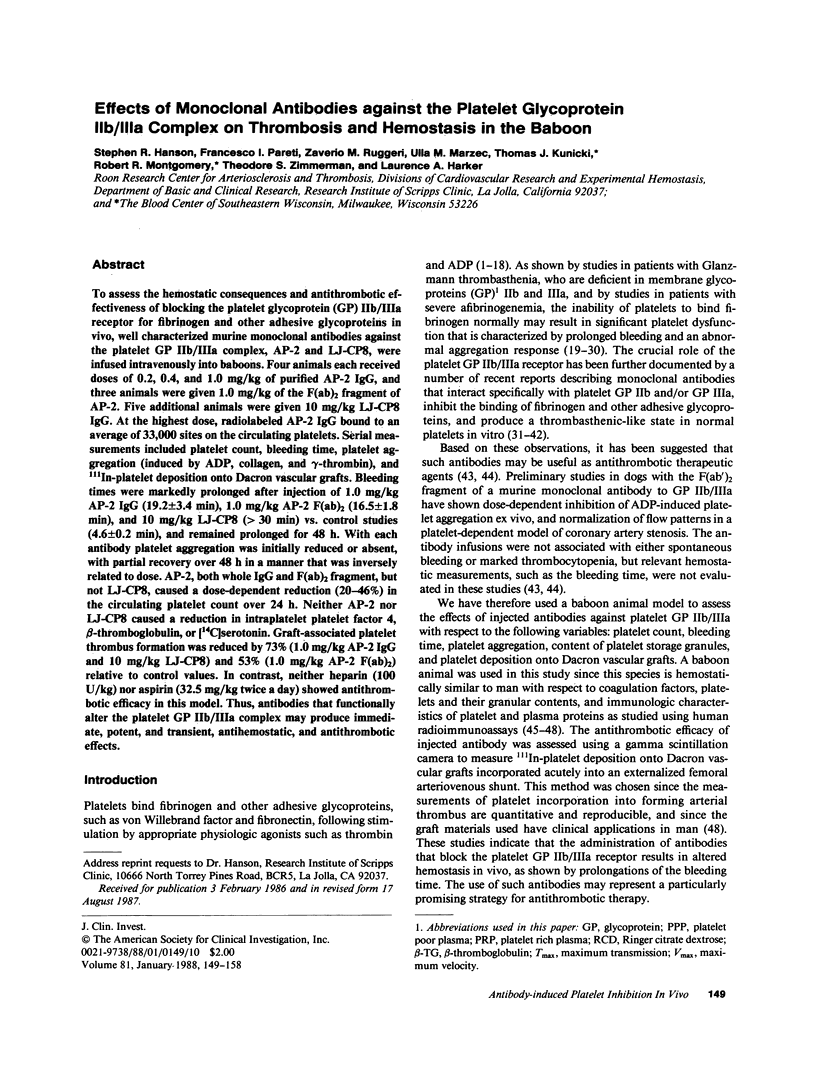
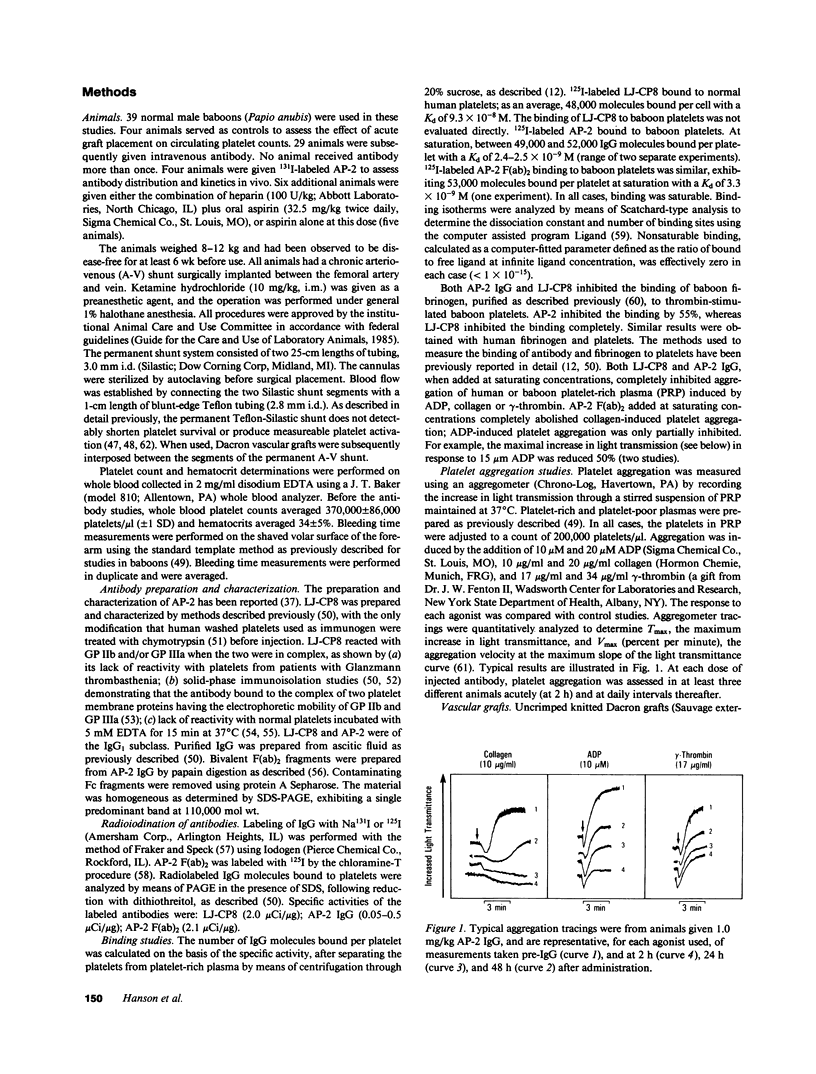
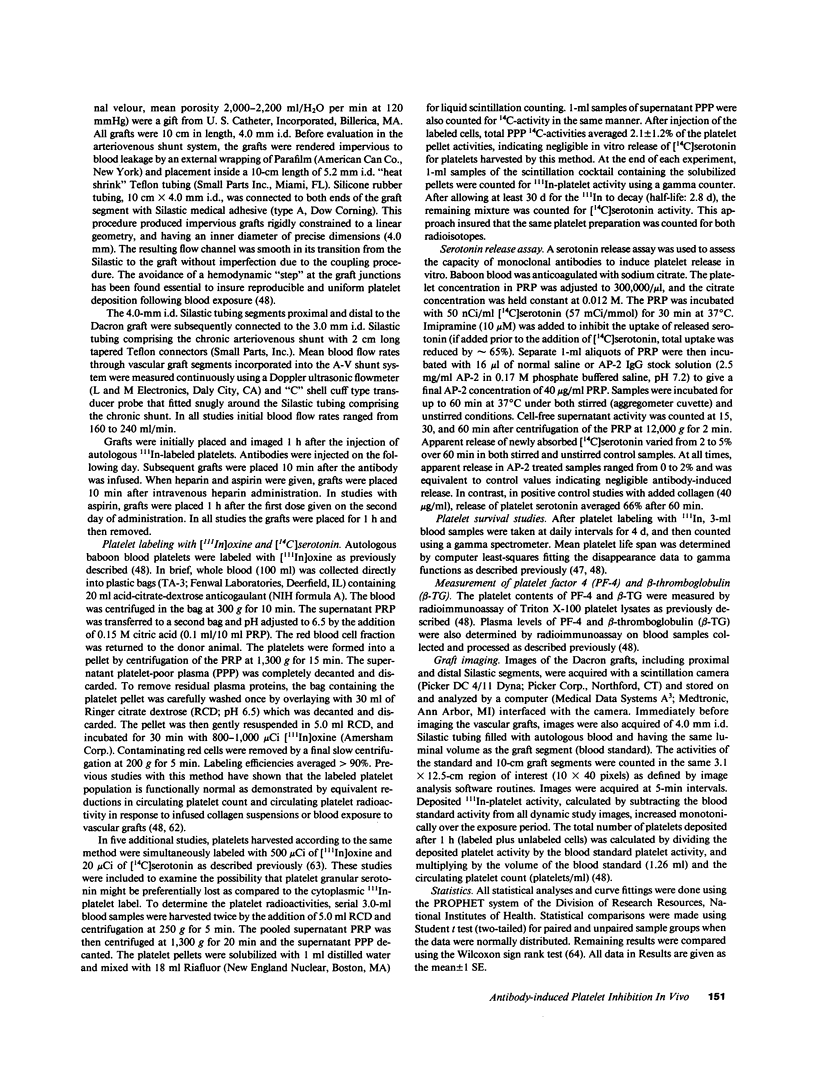

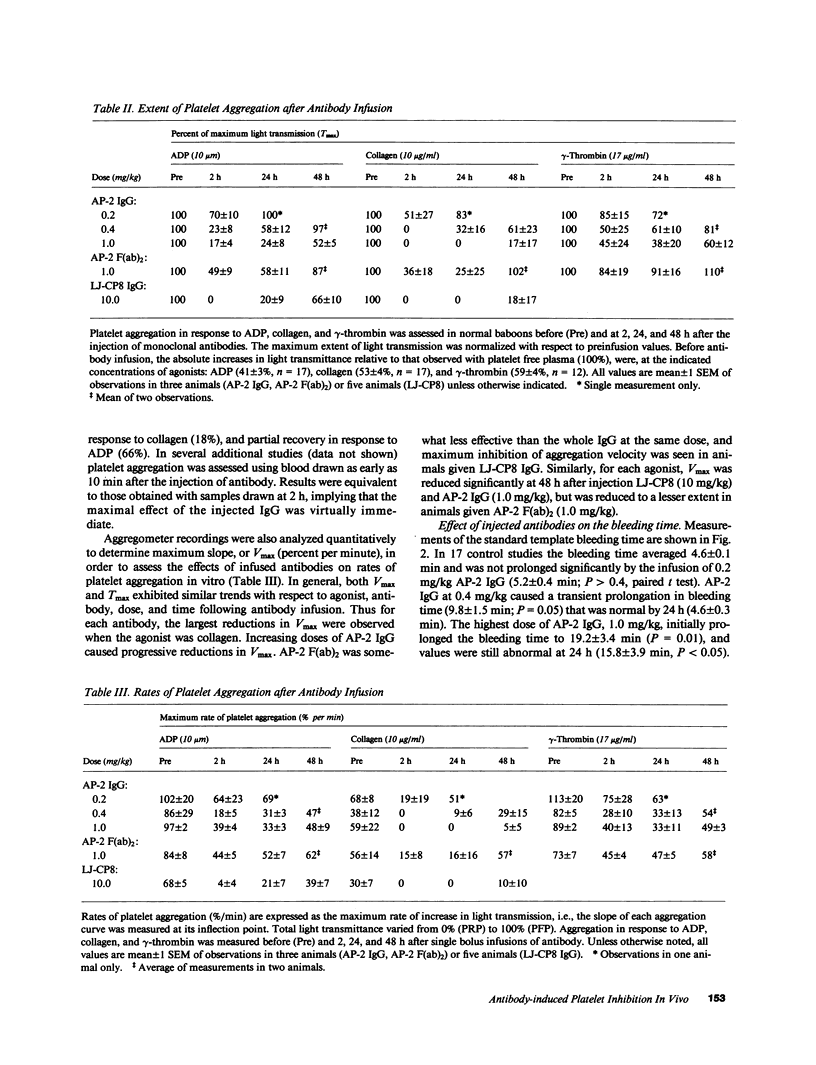




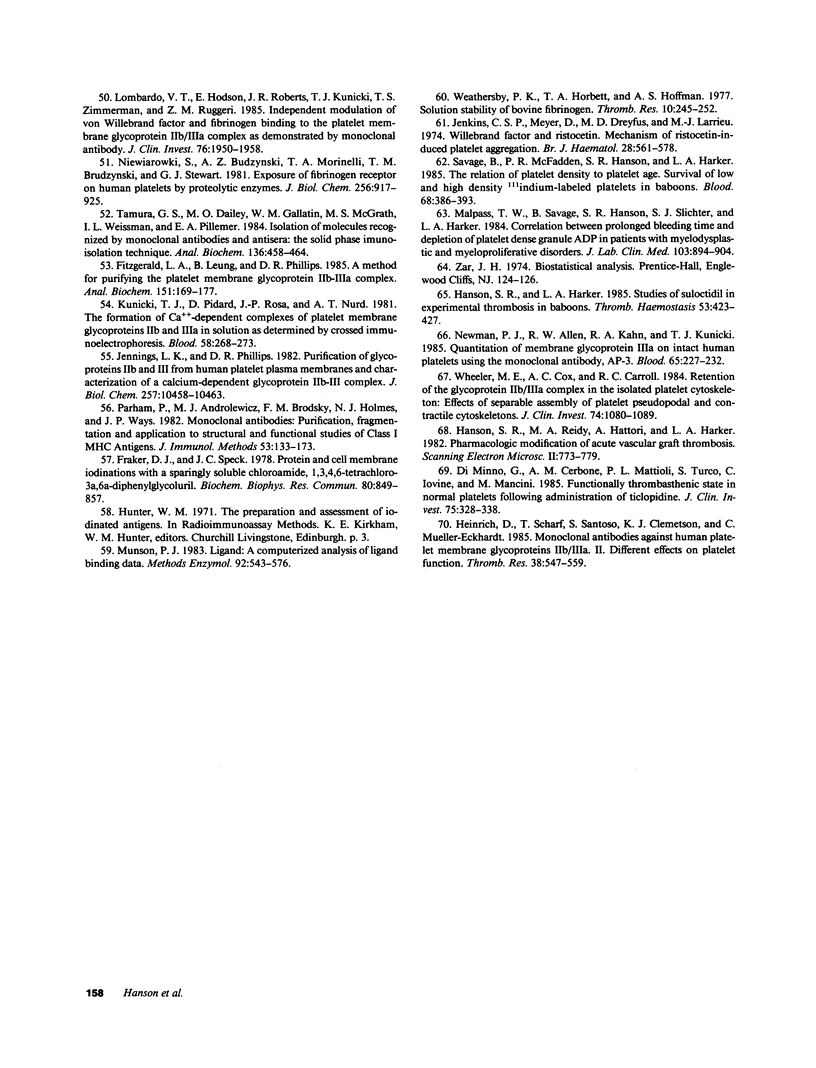
Images in this article
Selected References
These references are in PubMed. This may not be the complete list of references from this article.
- Bennett J. S., Hoxie J. A., Leitman S. F., Vilaire G., Cines D. B. Inhibition of fibrinogen binding to stimulated human platelets by a monoclonal antibody. Proc Natl Acad Sci U S A. 1983 May;80(9):2417–2421. doi: 10.1073/pnas.80.9.2417. [DOI] [PMC free article] [PubMed] [Google Scholar]
- Bennett J. S., Vilaire G. Exposure of platelet fibrinogen receptors by ADP and epinephrine. J Clin Invest. 1979 Nov;64(5):1393–1401. doi: 10.1172/JCI109597. [DOI] [PMC free article] [PubMed] [Google Scholar]
- Coller B. S. Interaction of normal, thrombasthenic, and Bernard-Soulier platelets with immobilized fibrinogen: defective platelet-fibrinogen interaction in thrombasthenia. Blood. 1980 Feb;55(2):169–178. [PubMed] [Google Scholar]
- Coller B. S., Peerschke E. I., Scudder L. E., Sullivan C. A. A murine monoclonal antibody that completely blocks the binding of fibrinogen to platelets produces a thrombasthenic-like state in normal platelets and binds to glycoproteins IIb and/or IIIa. J Clin Invest. 1983 Jul;72(1):325–338. doi: 10.1172/JCI110973. [DOI] [PMC free article] [PubMed] [Google Scholar]
- Coller B. S., Scudder L. E. Inhibition of dog platelet function by in vivo infusion of F(ab')2 fragments of a monoclonal antibody to the platelet glycoprotein IIb/IIIa receptor. Blood. 1985 Dec;66(6):1456–1459. [PubMed] [Google Scholar]
- Di Minno G., Cerbone A. M., Mattioli P. L., Turco S., Iovine C., Mancini M. Functionally thrombasthenic state in normal platelets following the administration of ticlopidine. J Clin Invest. 1985 Feb;75(2):328–338. doi: 10.1172/JCI111705. [DOI] [PMC free article] [PubMed] [Google Scholar]
- Di Minno G., Thiagarajan P., Perussia B., Martinez J., Shapiro S., Trinchieri G., Murphy S. Exposure of platelet fibrinogen-binding sites by collagen, arachidonic acid, and ADP: inhibition by a monoclonal antibody to the glycoprotein IIb-IIIa complex. Blood. 1983 Jan;61(1):140–148. [PubMed] [Google Scholar]
- Fitzgerald L. A., Leung B., Phillips D. R. A method for purifying the platelet membrane glycoprotein IIb-IIIa complex. Anal Biochem. 1985 Nov 15;151(1):169–177. doi: 10.1016/0003-2697(85)90067-3. [DOI] [PubMed] [Google Scholar]
- Fraker P. J., Speck J. C., Jr Protein and cell membrane iodinations with a sparingly soluble chloroamide, 1,3,4,6-tetrachloro-3a,6a-diphrenylglycoluril. Biochem Biophys Res Commun. 1978 Feb 28;80(4):849–857. doi: 10.1016/0006-291x(78)91322-0. [DOI] [PubMed] [Google Scholar]
- Fujimoto T., Hawiger J. Adenosine diphosphate induces binding of von Willebrand factor to human platelets. Nature. 1982 May 13;297(5862):154–156. doi: 10.1038/297154a0. [DOI] [PubMed] [Google Scholar]
- Fujimoto T., Ohara S., Hawiger J. Thrombin-induced exposure and prostacyclin inhibition of the receptor for factor VIII/von Willebrand factor on human platelets. J Clin Invest. 1982 Jun;69(6):1212–1222. doi: 10.1172/JCI110560. [DOI] [PMC free article] [PubMed] [Google Scholar]
- George J. N., Nurden A. T., Phillips D. R. Molecular defects in interactions of platelets with the vessel wall. N Engl J Med. 1984 Oct 25;311(17):1084–1098. doi: 10.1056/NEJM198410253111705. [DOI] [PubMed] [Google Scholar]
- Ginsberg M. H., Forsyth J., Lightsey A., Chediak J., Plow E. F. Reduced surface expression and binding of fibronectin by thrombin-stimulated thrombasthenic platelets. J Clin Invest. 1983 Mar;71(3):619–624. doi: 10.1172/JCI110808. [DOI] [PMC free article] [PubMed] [Google Scholar]
- Gralnick H. R., Williams S. B., Coller B. S. Fibrinogen competes with von Willebrand factor for binding to the glycoprotein IIb/IIIa complex when platelets are stimulated with thrombin. Blood. 1984 Oct;64(4):797–800. [PubMed] [Google Scholar]
- Gugler E., Lüscher E. F. Platelet function in congenital afibrinogenemia. Thromb Diath Haemorrh. 1965 Nov 15;14(3-4):361–373. [PubMed] [Google Scholar]
- Hagen I., Nurden A., Bjerrum O. J., Solum N. O., Caen J. Immunochemical evidence for protein abnormalities in platelets from patients with Glanzmann's thrombasthenia and Bernard-Soulier syndrome. J Clin Invest. 1980 Mar;65(3):722–731. doi: 10.1172/JCI109719. [DOI] [PMC free article] [PubMed] [Google Scholar]
- Hampton J. W., Matthews C. Similarities between baboon and human blood clotting. J Appl Physiol. 1966 Nov;21(6):1713–1716. doi: 10.1152/jappl.1966.21.6.1713. [DOI] [PubMed] [Google Scholar]
- Hanson S. R., Harker L. A., Bjornsson T. D. Effects of platelet-modifying drugs on arterial thromboembolism in baboons. Aspirin potentiates the antithrombotic actions of dipyridamole and sulfinpyrazone by mechanism(s) independent of platelet cyclooxygenase inhibition. J Clin Invest. 1985 May;75(5):1591–1599. doi: 10.1172/JCI111865. [DOI] [PMC free article] [PubMed] [Google Scholar]
- Hanson S. R., Harker L. A. Studies of suloctidil in experimental thrombosis in baboons. Thromb Haemost. 1985 Jun 24;53(3):423–427. [PubMed] [Google Scholar]
- Hanson S. R., Kotze H. F., Savage B., Harker L. A. Platelet interactions with Dacron vascular grafts. A model of acute thrombosis in baboons. Arteriosclerosis. 1985 Nov-Dec;5(6):595–603. doi: 10.1161/01.atv.5.6.595. [DOI] [PubMed] [Google Scholar]
- Hanson S. R., Reidy M. A., Hattori A., Harker L. A. Pharmacologic modification of acute vascular graft thrombosis. Scan Electron Microsc. 1982;(Pt 2):773–779. [PubMed] [Google Scholar]
- Heinrich D., Scharf T., Santoso S., Clemetson K. J., Mueller-Eckhardt C. Monoclonal antibodies against human platelet membrane glycoproteins IIb-IIIa. II. Different effects on platelet function. Thromb Res. 1985 Jun 1;38(5):547–559. doi: 10.1016/0049-3848(85)90187-2. [DOI] [PubMed] [Google Scholar]
- Jenkins C. S., Ali-Briggs E. F., Clemetson K. J. Antibodies against platelet membrane glycoproteins. II. Influence on ADP- and collagen-induced platelet aggregation, crossed immunoelectrophoresis studies and relevance to Glanzmann's thrombasthenia. Br J Haematol. 1981 Nov;49(3):439–447. doi: 10.1111/j.1365-2141.1981.tb07247.x. [DOI] [PubMed] [Google Scholar]
- Jenkins C. S., Meyer D., Dreyfus M. D., Larrieu M. J. Willebrand factor and ristocetin. I. Mechanism of rustocetin-induced platelet aggregation. Br J Haematol. 1974 Dec;28(4):561–578. doi: 10.1111/j.1365-2141.1974.tb06675.x. [DOI] [PubMed] [Google Scholar]
- Jennings L. K., Phillips D. R. Purification of glycoproteins IIb and III from human platelet plasma membranes and characterization of a calcium-dependent glycoprotein IIb-III complex. J Biol Chem. 1982 Sep 10;257(17):10458–10466. [PubMed] [Google Scholar]
- Jennings L. K., Phillips D. R., Walker W. S. Monoclonal antibodies to human platelet glycoprotein IIb beta that initiate distinct platelet responses. Blood. 1985 May;65(5):1112–1119. [PubMed] [Google Scholar]
- Kornecki E., Tuszynski G. P., Niewiarowski S. Inhibition of fibrinogen receptor-mediated platelet aggregation by heterologous anti-human platelet membrane antibody. Significance of an Mr = 66,000 protein derived from glycoprotein IIIa. J Biol Chem. 1983 Aug 10;258(15):9349–9356. [PubMed] [Google Scholar]
- Kunicki T. J., Pidard D., Rosa J. P., Nurden A. T. The formation of Ca++-dependent complexes of platelet membrane glycoproteins IIb and IIIa in solution as determined by crossed immunoelectrophoresis. Blood. 1981 Aug;58(2):268–278. [PubMed] [Google Scholar]
- Lee H., Nurden A. T., Thomaidis A., Caen J. P. Relationship between fibrinogen binding and the platelet glycoprotein deficiencies in Glanzmann's thrombasthenia type I and type II. Br J Haematol. 1981 May;48(1):47–57. doi: 10.1111/j.1365-2141.1981.00047.x. [DOI] [PubMed] [Google Scholar]
- Lombardo V. T., Hodson E., Roberts J. R., Kunicki T. J., Zimmerman T. S., Ruggeri Z. M. Independent modulation of von Willebrand factor and fibrinogen binding to the platelet membrane glycoprotein IIb/IIIa complex as demonstrated by monoclonal antibody. J Clin Invest. 1985 Nov;76(5):1950–1958. doi: 10.1172/JCI112193. [DOI] [PMC free article] [PubMed] [Google Scholar]
- Malpass T. W., Hanson S. R., Savage B., Hessel E. A., 2nd, Harker L. A. Prevention of acquired transient defect in platelet plug formation by infused prostacyclin. Blood. 1981 Apr;57(4):736–740. [PubMed] [Google Scholar]
- Malpass T. W., Savage B., Hanson S. R., Slichter S. J., Harker L. A. Correlation between prolonged bleeding time and depletion of platelet dense granule ADP in patients with myelodysplastic and myeloproliferative disorders. J Lab Clin Med. 1984 Jun;103(6):894–904. [PubMed] [Google Scholar]
- Marguerie G. A., Edgington T. S., Plow E. F. Interaction of fibrinogen with its platelet receptor as part of a multistep reaction in ADP-induced platelet aggregation. J Biol Chem. 1980 Jan 10;255(1):154–161. [PubMed] [Google Scholar]
- Marguerie G. A., Plow E. F., Edgington T. S. Human platelets possess an inducible and saturable receptor specific for fibrinogen. J Biol Chem. 1979 Jun 25;254(12):5357–5363. [PubMed] [Google Scholar]
- Marguerie G. A., Thomas-Maison N., Larrieu M. J., Plow E. F. The interaction of fibrinogen with human platelets in a plasma milieu. Blood. 1982 Jan;59(1):91–95. [PubMed] [Google Scholar]
- McEver R. P., Baenziger N. L., Majerus P. W. Isolation and quantitation of the platelet membrane glycoprotein deficient in thrombasthenia using a monoclonal hybridoma antibody. J Clin Invest. 1980 Dec;66(6):1311–1318. doi: 10.1172/JCI109983. [DOI] [PMC free article] [PubMed] [Google Scholar]
- McEver R. P., Bennett E. M., Martin M. N. Identification of two structurally and functionally distinct sites on human platelet membrane glycoprotein IIb-IIIa using monoclonal antibodies. J Biol Chem. 1983 Apr 25;258(8):5269–5275. [PubMed] [Google Scholar]
- Melero J. A., Gonzalez-Rodriguez J. Preparation of monoclonal antibodies against glycoprotein IIIa of human platelets. Their effect on platelet aggregation. Eur J Biochem. 1984 Jun 1;141(2):421–427. doi: 10.1111/j.1432-1033.1984.tb08208.x. [DOI] [PubMed] [Google Scholar]
- Munson P. J. LIGAND: a computerized analysis of ligand binding data. Methods Enzymol. 1983;92:543–576. doi: 10.1016/0076-6879(83)92044-x. [DOI] [PubMed] [Google Scholar]
- Mustard J. F., Kinlough-Rathbone R. L., Packham M. A., Perry D. W., Harfenist E. J., Pai K. R. Comparison of fibrinogen association with normal and thrombasthenic platelets on exposure to ADP or chymotrypsin. Blood. 1979 Nov;54(5):987–993. [PubMed] [Google Scholar]
- Mustard J. F., Packham M. A., Kinlough-Rathbone R. L., Perry D. W., Regoeczi E. Fibrinogen and ADP-induced platelet aggregation. Blood. 1978 Aug;52(2):453–466. [PubMed] [Google Scholar]
- Nachman R. L., Leung L. L. Complex formation of platelet membrane glycoproteins IIb and IIIa with fibrinogen. J Clin Invest. 1982 Feb;69(2):263–269. doi: 10.1172/JCI110448. [DOI] [PMC free article] [PubMed] [Google Scholar]
- Newman P. J., Allen R. W., Kahn R. A., Kunicki T. J. Quantitation of membrane glycoprotein IIIa on intact human platelets using the monoclonal antibody, AP-3. Blood. 1985 Jan;65(1):227–232. [PubMed] [Google Scholar]
- Niewiarowski S., Budzynski A. Z., Morinelli T. A., Brudzynski T. M., Stewart G. J. Exposure of fibrinogen receptor on human platelets by proteolytic enzymes. J Biol Chem. 1981 Jan 25;256(2):917–925. [PubMed] [Google Scholar]
- Parham P., Androlewicz M. J., Brodsky F. M., Holmes N. J., Ways J. P. Monoclonal antibodies: purification, fragmentation and application to structural and functional studies of class I MHC antigens. J Immunol Methods. 1982 Sep 17;53(2):133–173. doi: 10.1016/0022-1759(82)90137-5. [DOI] [PubMed] [Google Scholar]
- Peerschke E. I., Coller B. S. A murine monoclonal antibody that blocks fibrinogen binding to normal platelets also inhibits fibrinogen interactions with chymotrypsin-treated platelets. Blood. 1984 Jul;64(1):59–63. [PubMed] [Google Scholar]
- Peerschke E. I. Induction of human platelet fibrinogen receptors by epinephrine in the absence of released ADP. Blood. 1982 Jul;60(1):71–77. [PubMed] [Google Scholar]
- Peerschke E. I., Zucker M. B., Grant R. A., Egan J. J., Johnson M. M. Correlation between fibrinogen binding to human platelets and platelet aggregability. Blood. 1980 May;55(5):841–847. [PubMed] [Google Scholar]
- Phillips D. R., Agin P. P. Platelet membrane defects in Glanzmann's thrombasthenia. Evidence for decreased amounts of two major glycoproteins. J Clin Invest. 1977 Sep;60(3):535–545. doi: 10.1172/JCI108805. [DOI] [PMC free article] [PubMed] [Google Scholar]
- Phillips D. R. An evaluation of membrane glycoproteins in platelet adhesion and aggregation. Prog Hemost Thromb. 1980;5:81–109. [PubMed] [Google Scholar]
- Pidard D., Montgomery R. R., Bennett J. S., Kunicki T. J. Interaction of AP-2, a monoclonal antibody specific for the human platelet glycoprotein IIb-IIIa complex, with intact platelets. J Biol Chem. 1983 Oct 25;258(20):12582–12586. [PubMed] [Google Scholar]
- Plow E. F., Ginsberg M. H. Specific and saturable binding of plasma fibronectin to thrombin-stimulated human platelets. J Biol Chem. 1981 Sep 25;256(18):9477–9482. [PubMed] [Google Scholar]
- Plow E. F., Marguerie G. A. Induction of the fibrinogen receptor on human platelets by epinephrine and the combination of epinephrine and ADP. J Biol Chem. 1980 Nov 25;255(22):10971–10977. [PubMed] [Google Scholar]
- Plow E. F., Marguerie G. A. Participation of ADP in the binding of fibrinogen to thrombin-stimulated platelets. Blood. 1980 Sep;56(3):553–555. [PubMed] [Google Scholar]
- Plow E. F., McEver R. P., Coller B. S., Woods V. L., Jr, Marguerie G. A., Ginsberg M. H. Related binding mechanisms for fibrinogen, fibronectin, von Willebrand factor, and thrombospondin on thrombin-stimulated human platelets. Blood. 1985 Sep;66(3):724–727. [PubMed] [Google Scholar]
- Plow E. F., Srouji A. H., Meyer D., Marguerie G., Ginsberg M. H. Evidence that three adhesive proteins interact with a common recognition site on activated platelets. J Biol Chem. 1984 May 10;259(9):5388–5391. [PubMed] [Google Scholar]
- Ruan C., Tobelem G., McMichael A. J., Drouet L., Legrand Y., Degos L., Kieffer N., Lee H., Caen J. P. Monoclonal antibody to human platelet glycoprotein I. II. Effects on human platelet function. Br J Haematol. 1981 Dec;49(4):511–519. doi: 10.1111/j.1365-2141.1981.tb07259.x. [DOI] [PubMed] [Google Scholar]
- Ruggeri Z. M., Bader R., de Marco L. Glanzmann thrombasthenia: deficient binding of von Willebrand factor to thrombin-stimulated platelets. Proc Natl Acad Sci U S A. 1982 Oct;79(19):6038–6041. doi: 10.1073/pnas.79.19.6038. [DOI] [PMC free article] [PubMed] [Google Scholar]
- Ruggeri Z. M., De Marco L., Gatti L., Bader R., Montgomery R. R. Platelets have more than one binding site for von Willebrand factor. J Clin Invest. 1983 Jul;72(1):1–12. doi: 10.1172/JCI110946. [DOI] [PMC free article] [PubMed] [Google Scholar]
- Savage B., McFadden P. R., Hanson S. R., Harker L. A. The relation of platelet density to platelet age: survival of low- and high-density 111indium-labeled platelets in baboons. Blood. 1986 Aug;68(2):386–393. [PubMed] [Google Scholar]
- Tamura G. S., Dailey M. O., Gallatin W. M., McGrath M. S., Weissman I. L., Pillemer E. A. Isolation of molecules recognized by monoclonal antibodies and antisera: the solid phase immunoisolation technique. Anal Biochem. 1984 Feb;136(2):458–464. doi: 10.1016/0003-2697(84)90244-6. [DOI] [PubMed] [Google Scholar]
- Tetteroo P. A., Lansdorp P. M., Leeksma O. C., von dem Borne A. E. Monoclonal antibodies against human platelet glycoprotein IIIa. Br J Haematol. 1983 Nov;55(3):509–522. doi: 10.1111/j.1365-2141.1983.tb02166.x. [DOI] [PubMed] [Google Scholar]
- Todd M. E., McDevitt E., Goldsmith E. I. Blood-clotting mechanisms of nonhuman primates. Choice of the baboon model to simulate man. J Med Primatol. 1972;1(3):132–141. doi: 10.1159/000460376. [DOI] [PubMed] [Google Scholar]
- Weathersby P. K., Horbett T. A., Hoffman A. S. Solution stability of bovine fibrinogen. Thromb Res. 1977 Feb;10(2):245–252. doi: 10.1016/0049-3848(77)90006-8. [DOI] [PubMed] [Google Scholar]
- Weiss H. J., Kochwa S. Studies of platelet function and proteins in 3 patients with Glanzmann's thrombasthenia. J Lab Clin Med. 1968 Jan;71(1):153–165. [PubMed] [Google Scholar]
- Weiss H. J., Rogers J. Fibrinogen and platelets in the primary arrest of bleeding. Studies in two patients with congenital afibrinogenemia. N Engl J Med. 1971 Aug 12;285(7):369–374. doi: 10.1056/NEJM197108122850703. [DOI] [PubMed] [Google Scholar]
- Wheeler M. E., Cox A. C., Carroll R. C. Retention of the glycoprotein IIb-IIIa complex in the isolated platelet cytoskeleton. Effects of separable assembly of platelet pseudopodal and contractile cytoskeletons. J Clin Invest. 1984 Sep;74(3):1080–1089. doi: 10.1172/JCI111475. [DOI] [PMC free article] [PubMed] [Google Scholar]



